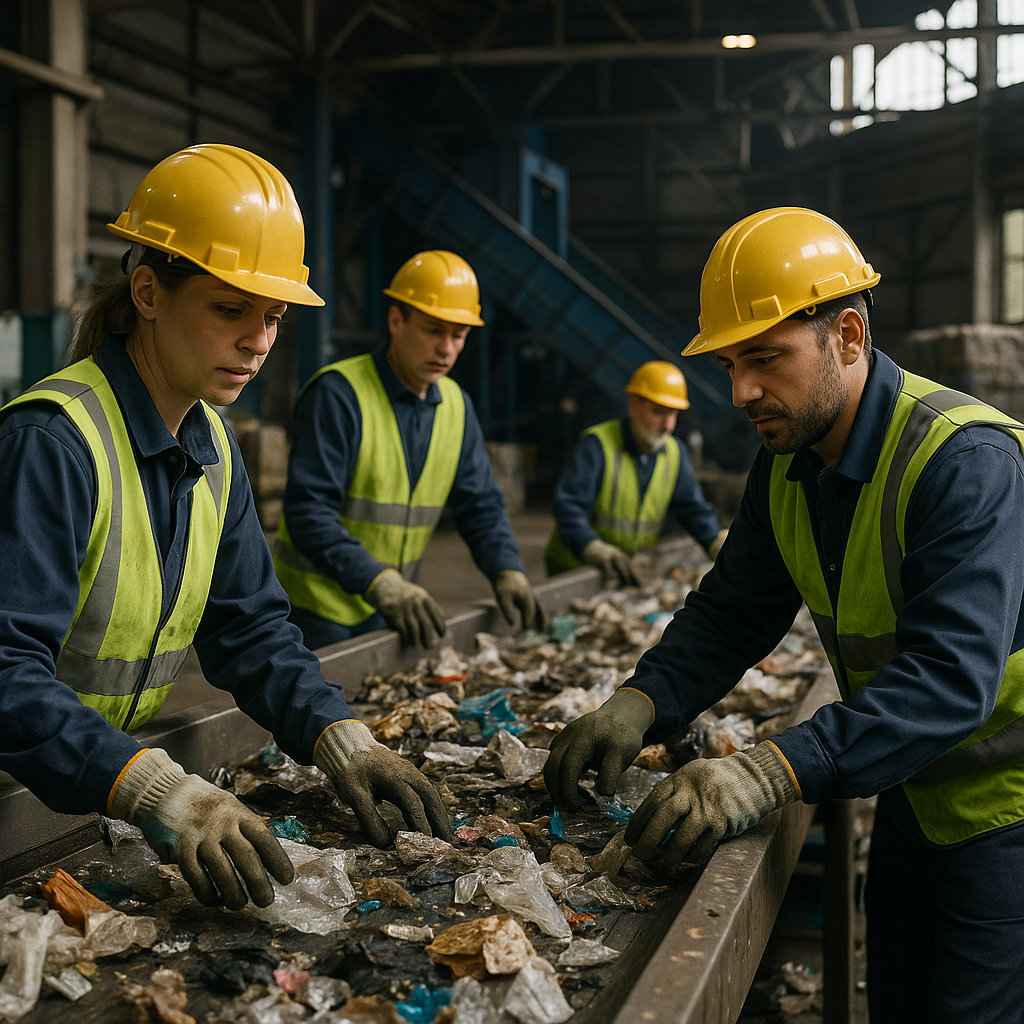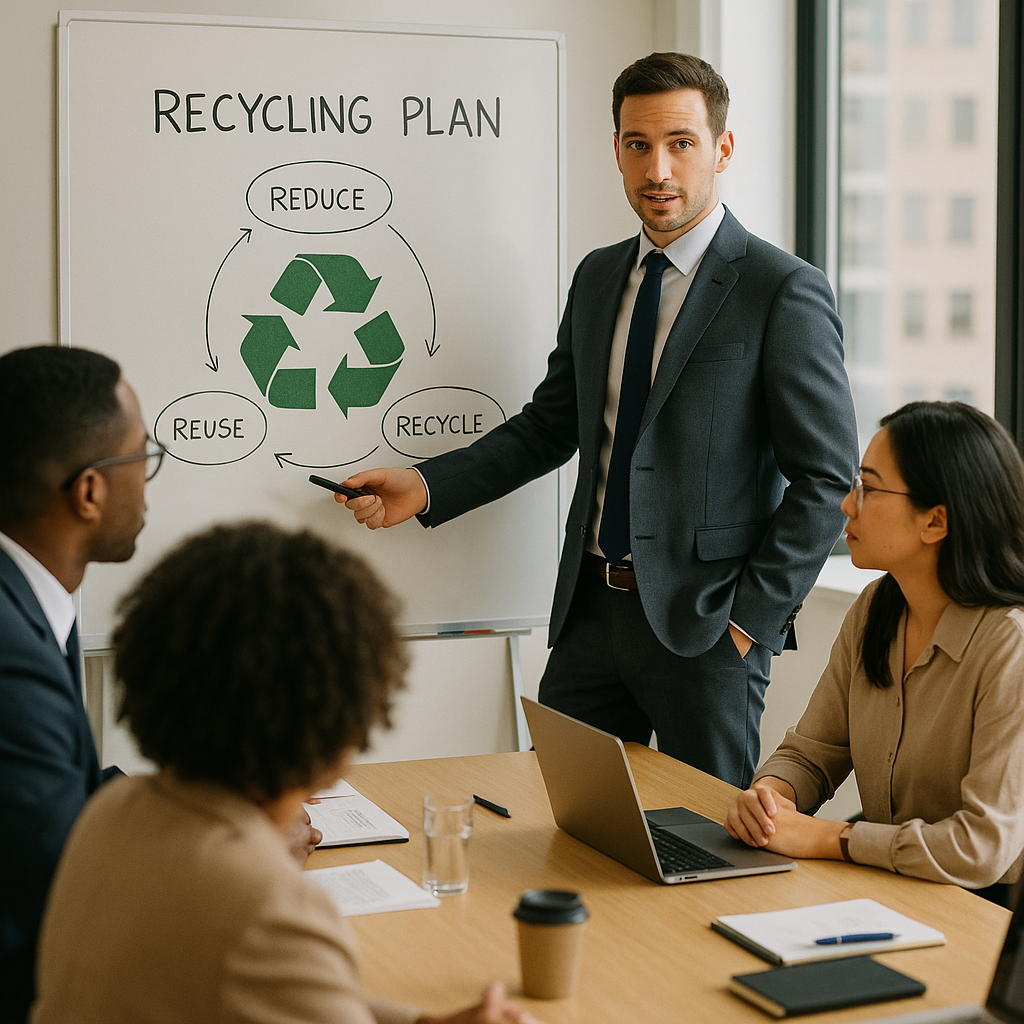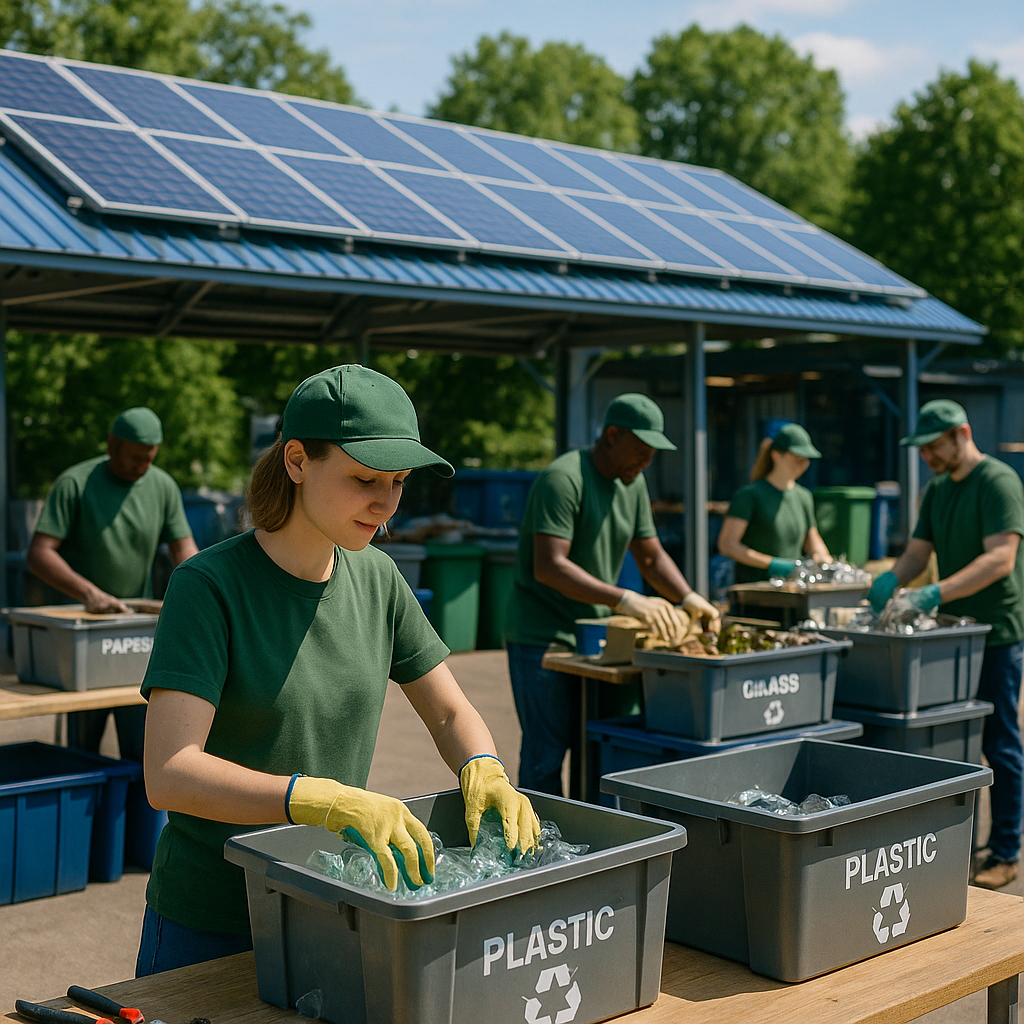5901 Botham Jean Blvd, Dallas, TX 75215
Industrial Recycling Challenges and Solutions: How Manufacturers Can Overcome Barriers
August 24, 2025Industrial recycling is essential for reducing environmental impact and recovering valuable resources. Despite its clear benefits, implementing successful recycling programs presents challenges. Many organizations face financial, logistical, and technological barriers that limit the effectiveness of their recycling efforts.
Identifying these obstacles is crucial for developing stronger, more sustainable waste management solutions.
Key Challenges in Industrial Recycling

Despite the clear environmental and economic benefits, industrial recycling faces significant obstacles that can hinder implementation and reduce effectiveness. Understanding these challenges is crucial for organizations aiming to develop sustainable waste management solutions.
Complex Waste Streams
Industrial waste typically contains various material types that are difficult to separate efficiently. Manufacturing byproducts often include mixed plastics, metals, chemicals, and other components that require specialized sorting technology.
For example, electronic waste contains valuable metals like copper and gold alongside hazardous materials such as lead and mercury. Without proper separation techniques, these materials can contaminate recyclable components, reducing their value or rendering them unsuitable for reprocessing.
Studies show that about 70% of industrial waste is improperly sorted, causing recoverable materials like plastics and aluminum to end up in landfills instead of recycling facilities. This contamination issue significantly affects recycling operations’ efficiency.
High Initial Investment Costs
Establishing effective industrial recycling programs requires substantial initial capital. Companies must invest in specialized equipment, collection infrastructure, and processing facilities. These costs can be prohibitive, especially for smaller businesses with limited financial resources.
The economic viability of recycling operations is further challenged by fluctuating market demands for recycled materials. When commodity prices for virgin materials are low, recycled alternatives may be less financially attractive, complicating the justification for the initial investment.
Many businesses face tough decisions about allocating resources to recycling infrastructure when the return on investment timeline may extend several years into the future.
Employee Engagement and Training
Successful industrial recycling programs require consistent employee participation. Workers need training to understand sorting procedures, recognize recyclable materials, and follow protocols for handling potentially hazardous waste.
Without adequate education and clear communication, employees may unknowingly contaminate recycling streams or fail to capture recyclable materials. Regular training sessions and visible reminders about proper waste disposal practices are essential but can be challenging to implement across large organizations.
Safety concerns also present challenges in recycling facilities. Workers face risks from handling hazardous materials, operating sorting equipment, and processing waste. These safety issues can discourage workforce participation and create additional training requirements.
Supply Chain Integration
Effective industrial recycling requires coordination throughout the entire supply chain. Every stage, from design and manufacturing to distribution and end-of-life handling, must consider recyclability and material recovery.
Companies often struggle to implement recycling practices that span multiple facilities, partners, and geographic locations. Standardizing procedures across diverse operations presents logistical challenges, especially for businesses with global supply networks.
Additionally, finding reliable markets for recycled materials can be difficult. Manufacturers may hesitate to incorporate recycled content into their products due to concerns about quality, consistency, or regulatory compliance.
Technological Limitations
Current recycling technologies have limitations that affect their effectiveness for certain industrial materials. Some complex composites and multi-material products cannot be efficiently recycled using existing methods.
While innovations in material separation techniques, such as optical sorting and advanced density separation, are improving recycling capabilities, the deployment of these technologies lags behind waste generation. Many recycling facilities operate with outdated equipment that cannot process newer material types.
The gap between technological capabilities and practical implementation poses a significant challenge for industrial recycling efforts.
| Challenge | Description | Potential Solutions |
|---|---|---|
| Complex Waste Streams | Industrial waste often includes multiple materials that are difficult to separate. | Implement advanced sorting technology and employee training for proper separation techniques. |
| High Initial Investment Costs | Significant upfront costs for recycling equipment and infrastructure. | Consider long-term savings, seek government grants, and explore partnerships to offset costs. |
| Employee Engagement and Training | Lack of employee training can lead to improper sorting and contamination. | Implement regular training programs and clear guidelines on recycling procedures. |
| Supply Chain Integration | Challenges in applying recycling practices across broad networks and partners. | Standardize procedures and collaborate with supply chain partners on recycling goals. |
| Technological Limitations | Existing recycling technologies may not handle certain complex materials efficiently. | Invest in new technologies like optical sorting and chemical recycling methods. |
| Regulatory Complexity | Different regulations across regions create compliance challenges. | Maintain specialized regulatory knowledge and ensure consistent compliance monitoring. |
Regulatory Complexity
Industrial recycling is subject to varying regulations at local, national, and international levels. Navigating this complex regulatory landscape requires specialized knowledge and continuous monitoring of changing requirements.
Compliance issues can arise from improper handling, documentation, or disposal of certain waste types. Hazardous materials, in particular, are subject to strict regulations that may differ by jurisdiction, adding complexity for companies operating across multiple regions.
The lack of standardized regulations can also create confusion and inconsistency in recycling practices, making it difficult for companies to develop unified approaches to waste management.
How Are Advanced Technologies Transforming Industrial Recycling?

Advanced technologies are fundamentally changing how industrial recycling operates. These innovations deliver unprecedented levels of efficiency and effectiveness in waste management systems. Integrating smart technologies not only improves recycling rates but also redefines what is possible in resource recovery.
Chemical Recycling: Breaking Down Materials at the Molecular Level
Chemical recycling represents a significant breakthrough in handling materials that traditional mechanical methods struggle with. Unlike conventional recycling, which often degrades material quality with each cycle, chemical processes break down polymers to their original building blocks.
This technology enables the recovery of high-quality raw materials from complex waste streams. For instance, pyrolysis uses heat in oxygen-free environments to convert mixed plastics into valuable oil and gas products. Similarly, chemolysis employs solvents and catalysts to break down polymers into their original monomers.
Enzyme-based recycling is emerging as another promising approach. Researchers have developed specialized enzymes that can decompose plastics like PET into their base components. This allows for true circularity, where materials can be endlessly recycled without losing quality.
IoT Sensors: Creating the ‘Internet of Waste’
The Internet of Things has revolutionized waste management with connected sensor networks. Smart bins equipped with ultrasonic sensors monitor fill levels in real-time, detecting when containers approach capacity and sending automated alerts to collection teams.
These systems eliminate unnecessary collection trips, reducing fuel consumption and carbon emissions. In some cities, IoT-enabled waste management has cut operational costs by up to 20% while significantly lowering environmental impact.
Beyond optimizing collections, IoT sensors monitor equipment performance in recycling facilities, tracking operational metrics and alerting operators to potential issues before they cause costly downtime. This predictive maintenance approach increases productivity and extends equipment lifespan.
Artificial Intelligence and Machine Learning
AI-powered image recognition systems have transformed recycling sorting operations. These technologies can identify and categorize materials with over 95% accuracy, far exceeding human capabilities. Advanced computer vision analyzes visual data to distinguish between dozens of different material types in milliseconds.
AI systems excel at detecting hazardous materials within waste streams, recognizing specific visual features of dangerous items that require special handling, preventing contamination, and protecting worker safety.
The data collected through AI systems provides valuable insights into waste composition. Facilities use this information to optimize sorting operations, increase recovery rates, and reduce contamination. This intelligence helps facility managers make data-driven decisions that improve overall efficiency.
Robotics: The Physical Force of Smart Recycling
Robotic sorting systems represent the physical implementation of AI intelligence in recycling facilities. These machines process materials up to four times faster than manual sorting methods while maintaining higher accuracy rates.
Companies like AMP Robotics have developed systems where AI vision captures images and identifies items based on material type, shape, color, and even brand. The AI then directs robotic arms to pick and sort waste with remarkable precision.
Specialized robotics have emerged for specific waste streams. For example, ZenRobotics has created the Heavy Picker for bulky construction waste and the Fast Picker for lighter materials. Their AI system, ZenBrain, excels at sorting construction and demolition waste.
These robotic systems improve worker safety by handling hazardous materials and performing repetitive tasks that can cause injuries. They operate continuously without fatigue, dramatically increasing processing capacity.
Big Data Analytics: Finding Patterns in Waste
Big data analytics transform how recycling facilities understand and manage their operations. By analyzing massive datasets from throughout the recycling process, facilities gain insights that were previously impossible to access.
These analytics track vehicle usage patterns, helping optimize fleet management and reduce fuel consumption. They monitor bin fill levels to create optimized collection schedules that prevent overflow while improving efficiency.
Cost analysis through big data helps identify areas for savings in fuel, labor, and maintenance. Route optimization reduces travel time and emissions while ensuring timely pickups. Distribution analysis ensures optimal placement of collection points based on waste generation patterns.
Perhaps most valuable is the predictive capability of big data. Advanced analytics can forecast waste generation trends, helping facilities prepare for seasonal variations or changing material streams. This forward-looking approach allows for more strategic planning and resource allocation.
| Technology | Process | Outputs/Benefits |
|---|---|---|
| Chemical Recycling | Breaks down plastics to monomers | High-quality raw materials |
| Pyrolysis | Heats plastics in absence of oxygen | Oil and gas products |
| Gasification | Converts waste into syngas | Energy and chemical products |
| Enzyme-based Recycling | Uses enzymes to break down plastics | Recyclable base components |
| IoT Sensors | Monitors waste levels and equipment | Collection efficiency, reduced emissions |
| AI and Machine Learning | Identifies and sorts materials | Higher accuracy and recovery rates |
| Robotics | Automated material sorting | Increased processing speed and safety |
| Big Data Analytics | Analyzes recycling process data | Efficiency optimization and cost savings |
Integration Creates Powerful Synergies
The true power of these technologies emerges when they work together in integrated systems. IoT sensors collect data that feed AI algorithms. AI directs robotic sorting systems. Big data analytics process information from all these sources to continually optimize operations.
For example, in smart factories, the combination of IoT, AI, and predictive analytics has reduced energy consumption by 10% and cut manufacturing costs by 5-10%. These same principles applied to recycling facilities drive similar efficiency gains.
The integration of these technologies is creating recycling facilities that are more efficient, safer, and more profitable than ever before. As these technologies mature and become more affordable, their adoption across the recycling industry is expected to accelerate.
Conclusion: The Future of Industrial Recycling

Industrial recycling has transformed significantly, shifting from being merely an environmental obligation to a strategic business advantage with tangible returns. By converting manufacturing waste into valuable resources, companies can reduce operational costs, meet increasingly stringent sustainability goals, and contribute meaningfully to a circular economy.
Data supports this shift: companies implementing circular economy principles can decrease CO2 emissions by over 39% by recovering and reusing resources throughout product lifecycles. Technologies like AI-powered waste analytics, digital twins, and automated compliance systems are making industrial recycling more efficient and accessible. These innovations help manufacturers overcome traditional implementation barriers while strengthening their competitive position in markets where sustainability increasingly influences purchasing decisions.
For organizations aiming to optimize waste management strategies and capitalize on these opportunities, contact Okon Recycling at 214-717-4083. Our team of experts can help assess your current processes, identify potential improvements, and implement sustainable recycling solutions tailored to your specific industrial needs.
